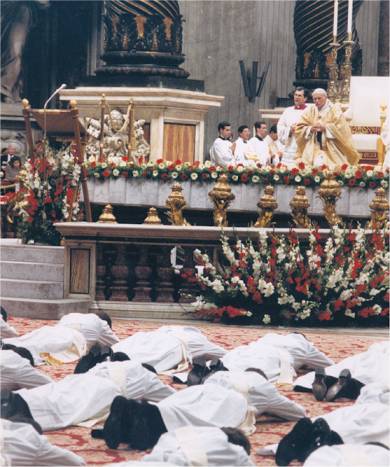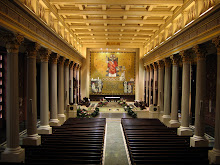My next series in the Catholic Telegraph, on the Year for Priests runs this week.
We have been examining the development of priestly identity in the Jewish Scriptures over these last few months, culminating my last column with Jesus fulfilling the Passover rituals during His entrance into glory through His Paschal mystery.
Even with these discussions, there remains debate among Scripture scholars about Jesus’ own identity as a priest: ‘Did Jesus identify Himself as a priest?’ It seems like such an obvious question, yet debate rages.
A major factor that argues against Jesus’ self identity as a priest is that His ancestry is through the tribe of Judah, not Levi, the priestly tribe. We have already discussed how the tribe of Levi took over the priestly duties because of their zeal, so we see Jesus returning to an even older source of the priesthood in Melchizedek, which remains the source of the Catholic Priesthood..
But it still does not answer how Jesus identifies himself as a priest, and while we can certainly look to the events of His passion to see Jesus as a priest; for those who can see, Jesus’ priestly identity is manifest even from the beginning of his public ministry.
Turning to the Gospel of Mark, we see Jesus affect three healings that would, in the Mosaic Law Code, cause Him to contract ritual impurity: the healing of a leper, the curing of the woman afflicted with the hemorrhage, and the raising of Jairus’ daughter from the dead. In the Jewish mindset, all three of these events brought impurity upon the one who touched the other. Yet, especially in the curing of the woman with the hemorrhage in Mark 5:25-34, Jesus feels power going out of him. His purity and close connection with the Father enables Him to perform a priestly function in restoring others to health, to wholeness.
Admittedly, these references do not seem to have much to do with a priestly identity, but they come to light through a reading of the Passion Narratives. While all the Passion Narratives have priestly language, it comes through strongest in the Gospel of John. In fact, chapter 17 is known as the Great Priestly Prayer of Jesus in which he prays for His disciples that we might be drawn into the unity that exists between Him and His Father in Heaven. (Which is what priests still pray during the Mass.)
Even more telling is the confrontation between Jesus and Caiaphas and Annas, the high priest and his father, respectively, at the time of Jesus’ trial. In John’s account, Jesus is clearly in charge of the proceedings. He does not go as an unwilling lamb, meek and humble; He goes forward as a priest willingly offering Himself as a sacrifice.
A deeper sign that Jesus truly does identify Himself as the new High Priest is easy to miss. When he is stripped prior to being nailed on the Cross, there is a curious detail that His tunic was ‘woven in one piece from top to bottom and had no seam. (John 19:24)’ While seemingly insignificant, in the description of the High Priest’s garments in the Old Testament (See Leviticus 16), we see that the high priest as a descendent of Aaron would wear a seamless tunic made of linen during the Day of Atonement, when he offered sacrifice for the sake of the people, creating strong parallels with Jesus’ self sacrifice. These are but some of the intricate details that show Jesus truly as the new High Priest, fulfilling all the promises of the Old Covenant, and inaugurating the New and Everlasting Covenant in His own blood.
****
To learn more about Jesus, the High Priest, the faithful of the Archdiocese of Cincinnati are invited to the next Call of the King Conference, which is taking place at 7:00 PM on September 27th at Our Lady of the Holy Spirit Center in Norwood or October 11th at Holy Angels in Sidney. Archbishop Dennis Schnurr is delivering the keynote address on building a culture of vocations in the parish and diocese. Please see http://










2 comments:
Thanks Fr. Kyle,
I always wondered about the significance of the seamless garment.
Myles
You wrote (right menu): “of linen during the Day of Atonement, when he offered sacrifice for the sake of the people, creating strong parallels with Jesus’ self sacrifice”
You wrote about atonement and I want to comment on that.
(le-havdil) The same that is outlined in Tan’’kh about kipur – atonement – was taught by first century Ribi Yehoshua (the Messiah) from Nazareth. Ribi Yehoshua taught in accordance with the teachings in Torah about the only way to get atonement and thereby enable a connection with ha-Sheim.
Read more here: www.netzarim.co.il
Anders Branderud
Post a Comment